Why do companies send hundreds of emails every year? Simple! It generates a staggering ROI of 3600%.
As email marketing service providers, we always stay curious about the impact of our work. So, we thought, why not curate the latest email marketing trends and statistics to see how email affects businesses globally.
Let’s look at these email marketing stats one by one.
Popular Email Marketing Statistics
Almost every marketer is curious about their campaign performance. They want to know open rates for email campaigns along with some other KPIs.
But what’s a comparison metric for performance? Here are some numbers to peg your performance against email marketing benchmarks.
Email Marketing Campaign Statistics
Before we dig deeper into specific performance metrics, here are some general statistics in favor of email marketing.
- Email marketing market size was $7.5 billion in 2020, which will cross $12 billion by the end of 2024.*
- 41% of marketers admit that email is their most effective marketing channel.*
- 77% of marketers have reported an increase in email engagement in the last 12 months.*
- 81% of small and medium business professionals believe that email marketing increases customer retention and helps acquire customers.*
Email Engagement Statistics
Email marketing is effective in engaging your audience and driving revenue. Here are some newsletter engagement metrics that support the statement:
- Average email deliverability is at 81%, with abandoned cart email success rates at the highest, converting 3 times more than other automated emails.*
- Mobile devices account for 43.5% of all email opens.*
- Personalization improves email open rates: emails with personalized subject lines see a 20.66% open rate compared to 19.57% for non-personalized ones.*
- The average open rate across various industries shows variation, with faith-based organizations leading at 44.11% and technology services at the lower end at 18.34%.

Email User Behavior Statistics
How do your email subscribers behave when reading and engaging with emails? We’ve got some answers. Have a look at some data sets revealing about everyday subscriber engagement:
- 61% of all emails are read for 8 seconds or more. Almost a quarter (23.5%) of all emails get skimmed (an engagement of 2-8 seconds), and 15% of all messages get less than 2 seconds of their readers’ attention.*
- 38% of active users want emails to include product ratings, and 35% want to see offers based on past purchases.*
- 28% of email users check their email inbox more than 10 times a day, and 4% – less than daily. Overall, 65% of respondents noted checking their email more than 3 times daily.*
- 67% of consumers would provide an email address in exchange for free shipping or a 5$ gift card.*
- 77% of users report boredom as the main reason for checking emails.*
- 70% check their email in bed, and almost as many as the people who check after waking up.*
- Of customers who opt-in for brand emails but mostly ignore them without unsubscribing, 37% are waiting for the right offer, and 24% say they plan to buy from the brand again.*
- The average time spent reading an email increased from 10.4 seconds in 2018 to 13.4 seconds in 2020.*
- As of 2023, the average email bounce rate is 2.3%.
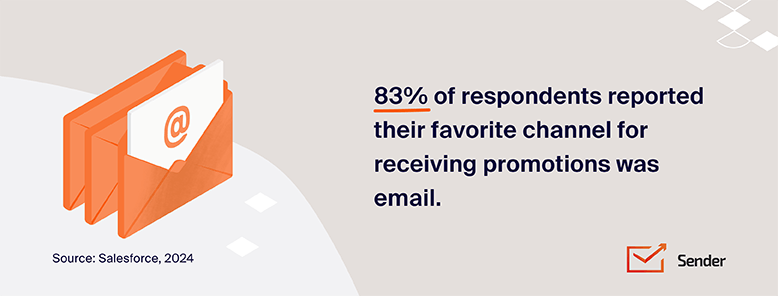
Open Rate Statistics
When evaluating the success of any email marketing campaign, the first question is “How many people opened the email?”.
Here are some industry benchmarks and average email open rates by industry:
- 47% of email recipients open an email based on the subject line alone, and 69% of email recipients report email as spam based solely on the subject line.*
- Emails with preheaders get an open rate of 32.95%. Personalized email marketing campaigns have an open rate of 30.26%.*
- Out of the three types of email, automated emails stand second behind transactional emails for unique open rates (41%), click rates (13%), and click-to-open rates (24%).*
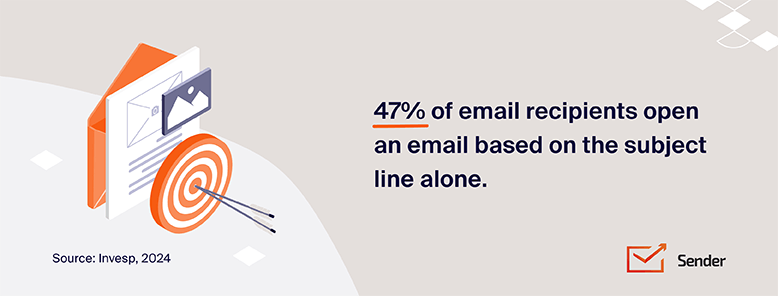
Open Rates by Industry
| Industry | Open Rate | Click Rate | Bounce Rate |
| Education | 41.56% | 2.42% | 8.89% |
| Dining & Food Services | 35.05% | 0.88% | 8.18% |
| Real Estate | 36.00% | 1.41% | 13.85% |
| Retail | 35.65% | 1.23% | 8.48% |
| Technology Services | 24.28% | 3.30% | 9.82% |
Click-Through Rate Statistics
The click-through rate (CTR) tells how many people clicked any of the links within your email. If you’re serious about link clicks, here are some statistics:
- Internet marketing has the lowest average click-through rate (CTR) at 1.68%.*
- Communications as an industry has the highest average CTR at 5.77%.*
- In March and April 2020, CTR of promotional emails in the food and beverages industry increased from 1.68% to 2.78%. Travel, hospitality, and leisure saw a decrease in its CTR, from 1.44% in March to 1.31% in April.*
- Emails linking to invoices and payments had the highest CTR at 25.7%. Link to a resource, such as a blog, had a CTR of 6.7%. Both links to offer and link to poll stood at 2.8%.*
Click-Through Rate Data and Trends
If the last section made you curious about the CTR trends in the future, we’ve got some deeper insights. Click-through rates depend on the industry, type of email, and several other factors.
Click-through Rate by Email Type
| Type of Email | Click-through Rate |
| Triggered emails | 3.69% |
| Autoresponder emails | 4.26% |
| Newsletters | 2.13% |
| RSS emails | 7.24% |
Email Conversion Rate Statistics
Marketing professionals like us are mostly interested in conversions for evaluating a channel’s success. Let’s see what the data has to say about email conversion rates:
- In 2021, the average email conversion rate was 15.2%. This rate peaked in 2018 when it was converting over 18.4% and has slightly been decreasing since then.*
- Abandoned cart emails convert 3x more than other automated emails.*
You can reach these numbers too — with Sender, it’s easy and affordable.
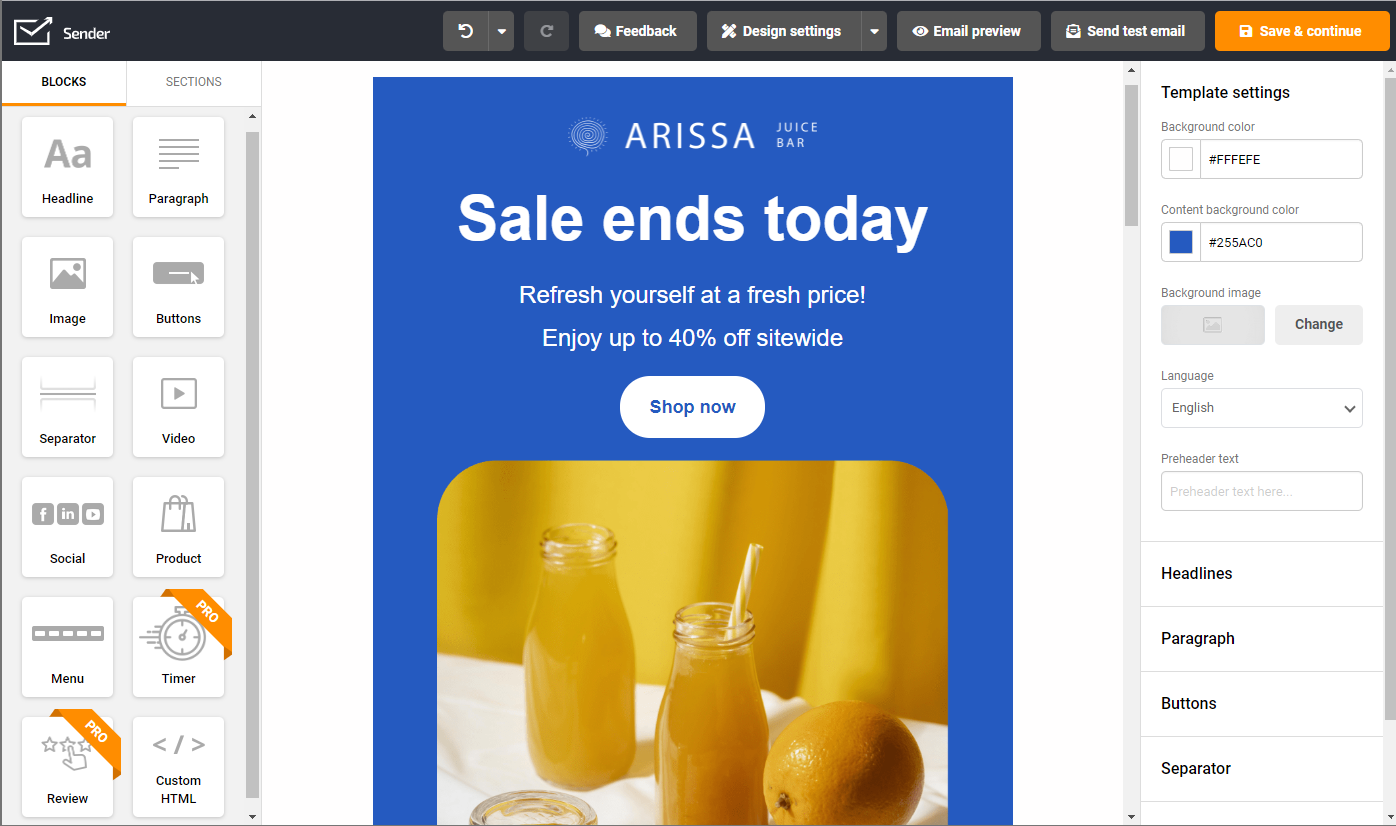
Email Marketing ROI and Financial Impact
ROI tells us how our email marketing efforts are impacting the bottom line — revenues of the company. Let’s look at some statistics about email marketing revenue and how it is one of the most rewarding marketing channels.
Email Marketing ROI Statistics in 2025
The first email campaign, sent in 1978, generated $13 million in sales. Since then, companies have been enjoying great returns from email marketing campaigns. Here are some numbers about email marketing ROI:
- Email marketing generates, on average, $36 for every dollar spent.*
- 18% of companies generate $70 in revenue for every 1 dollar spent.*
- 59% of marketers believe email is twice as effective in generating leads than other mediums like social media and PPC.*
- Email marketing acquires 40 times more customers than Meta & X.com combined.*
What is the Average ROI for Email Marketing?
ROI (Return on Investment) is one of the most talked about email marketing metrics out there. According to research, email marketing offers an ROI of up to 3600% . However, it may vary based on the industry you work in.
Here’s the ROI from email marketing across some industries.
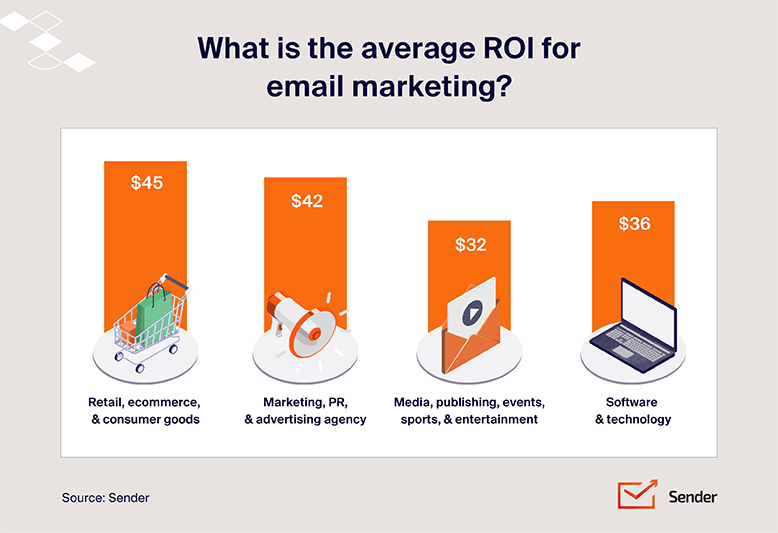
Email Marketing Content and Design Stats
Email is a popular channel to distribute content globally. It helps communicate directly with your audience. However, success depends on the way you write and design your emails.
Let’s look at some statistics highlighting the impact of email visuals on engagement.
Email Design and Content Statistics
If you’re curious about how you should design your next marketing campaign, here are some trends and numbers, including email subject line statistics, to guide your decisions.
- 87% of marketers prefer to use email marketing to promote their content.*
- Using personalization in email body may lead to a 28.57% increase in click-throughs (2.7% rate with tailored content vs. 2.1% without)
- Email is the third-highest owned media platform B2B marketers used to distribute content in the past 12 months.*
- 81% of B2B marketers say their most used form of content marketing is email newsletters.*
- The effectiveness of email subject lines depends on their ability to make readers curious, attractive promotional offers, and personalization.*
- Shorter subject lines (under 70 characters) have the highest open rates.*
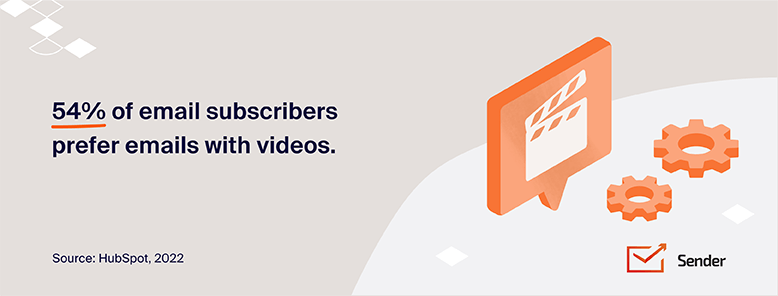
Email Frequency Statistics
How many emails you send also has an impact on your email marketing success, just like what you include in your emails. Here are some numbers:
- Consumers prefer to receive emails from their favorite brands just a few times per month.*
- 54% of brands opt to send emails 2-4 times per month, with 32% sending emails once a month. Fewer brands send emails 5-9 times per month (8%) or more frequently (6%). Interestingly, sending emails once a month had the highest open rate at 28%, with 2-4 emails a month following closely behind.
- In the B2C sector, some studies suggest trying frequencies as high as 10-19 times a month for potentially higher sales, though this might not suit every audience. For B2B communications, most companies find emailing twice a month optimal, as increasing the frequency to more than once a week significantly boosts the unsubscribe rate.
Email Marketing Targeting and Personalization Stats
Email Segmentation Statistics
Segmentation plays a crucial role in deciding the success of email marketing campaigns. Here’s some research data about email segmentation effectiveness:
- Segmented email campaigns drive 30% more opens and 50% more click-throughs than unsegmented ones.*
- 78% of marketers state that the most effective strategy for email marketing campaigns is subscriber segmentation.*
- 4 out of 5 marketers personalize subscriber profile data and 64% use customer segments.*
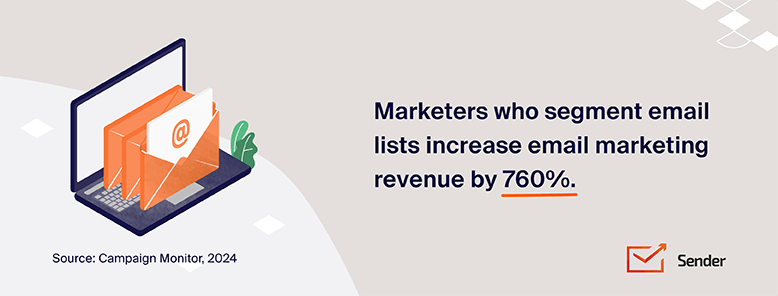
Personalized Email Marketing Statistics
Personalization is a big trend that can drive a positive impact for your campaigns. In fact, using dynamic content in emails is a top tactic used by email marketers.
Here are some statistics about personalized email performance:
- Message personalization is one of the top tactics to optimize emails.*
- Research shows that personalized emails generate 6x higher transaction rates compared to non-personalized versions.*
- 88% of users agree they are more likely to respond to an email favorably if it looks like it’s been specifically created for them.*
- Email marketers who segmented their audience before campaigning stated that the revenue generated increased to up to 760%.*
- 55% of marketers reveal that expanding the use of personalization is their biggest priority in the next 12 months.*
- 80% of customers are more likely to purchase after a personalized experience.*
- 90% of marketers believe personalization is crucial for their business and marketing strategies.*
- 4 out of 5 marketers personalize using subscriber profile data and 64% of marketers personalize using customer segments.*
Email Marketing Automation and Efficiency Statistics
Did you know 87% of marketers use marketing automation for emails? If you want better results, you must leverage automation. We’re not saying that, but the numbers don’t lie. Check the latest marketing automation email statistics in the next section.
Email Automation Statistics
If you ask marketers, they’ll say that email automation is the best thing since sliced bread. It helps us send the right message to the right audience at the right time, every time.
Let’s look at some automated email workflow statistics to support the theory:
- Automation is primarily used in email marketing to send triggered emails, drip or nurture campaigns, and segmentation.*
- Email automation campaigns (71%) are the third most effective email marketing strategy after subscriber segmentation (78%) and message personalization (72%).
- 48% of marketers said they plan to apply email marketing automation in their email campaigns.*
- Out of the three types of email, automated emails stand second behind transactional emails for unique open rates (41%), click rates (13%), and click-to-open rates (24%).*
Types of Emails Marketers Send
Email marketing is effective in reaching diverse audiences, engaging them, and achieving significant ROI. Here’s some analytical data to illustrate it:
- Newsletters are the most popular email type, used by 81% of marketers.*
- Welcome emails follow closely at 79%.*
- Product emails highlighting specific products or features are used by 75%.*
- Sales or promotions emails make up 72% of all emails sent by marketers.*
- Event announcements are sent by 71% of marketers.*
- Onboarding or post-purchase emails are used by 62% of brands and marketers.*
Brands are also known to utilize customer winbacks, blogs, re-engagement, and cart abandonment emails throughout the buyer’s lifecycle.
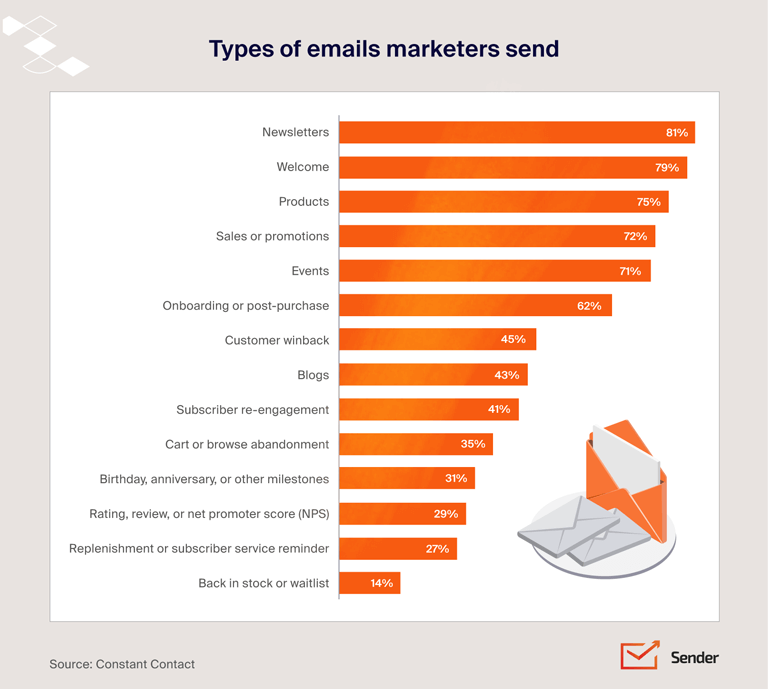
B2B, B2C, and Industry-Specific Insights
Whether you’re in the B2B or B2C industry, email marketing can work wonders for both. We’ve curated some latest email marketing statistics for B2B & B2C industry:
B2B Email Marketing Statistics
For the B2B industry, email marketing is the primary method to distribute content and nurture leads.
Here’s the latest B2B email marketing data:
- Email is the third-highest-owned media platform B2B marketers use to distribute content.*
- 69% of B2B marketers use email to distribute content in the last 12 months.*
- Email engagement is the fourth most important metric for B2B marketers for measuring B2B content performance*
- 81% of B2B marketers say their most used form of content marketing is email newsletters.*
- 14.3% of all emails go missing or have been caught by popular spam filters.*
- B2B marketers say that new product and feature announcement marketing emails have the highest click-through rate.*
- B2B buyers and consumers feel overwhelmed by the volume of emails, and 67% set up a junk email account to dodge unwanted emails.*
- The biggest blockers marketers face during email production are building (41%), designing (40%), and testing (39%).*
B2C Email Marketing Statistics
Email is one of the most rewarding channels for B2C businesses if you look at open rates, click rates, and conversion rates. Here are the latest B2C email marketing insights:
- 87% of B2C marketers leverage automation as part of their email marketing strategy.*
- Your audience will reward you with higher open and click rates if you don’t send more than five newsletters a week.*
- 60% of retail, ecommerce, and consumer goods and services companies are personalizing emails based on past purchases, versus 38% in 2019.*
- More than 8 out of 10 people will open a welcome email, generating 4x as many opens and 10x as many clicks as other email types.*
- 4 out of 5 marketers personalize emails with profile data, and 64% personalize them by segment.*
- Nearly 21% of all email campaigns are opened within the first hour of sending.*
- 60% of respondents say that marketing emails have influenced their purchases.*
- 64% of B2C marketers consider accessibility when creating their emails.*
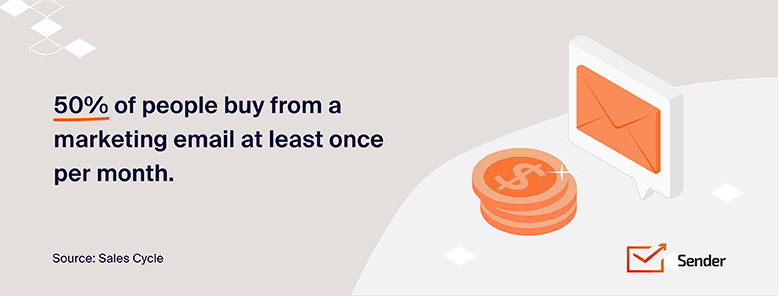
Ecommerce Email Marketing Statistics
As an ecommerce business owner or marketer, these statistics are not just interesting, but directly relevant to your business:
- 34% of consumers are more likely to purchase from email marketing.*
- 59% of people say that email marketing affects purchasing decisions.*
- 60% of consumers made a purchase thanks to a marketing email they received.*
- 51% of US online shoppers prefer email channels over other options (in-app notifications, SMS, and push notifications) to receive discounts.*
- Around 62% of B2C and B2B marketers in the US increased their email marketing budget in the past 12 months, more than any other channel, including social media (62%) and influencer marketing (50%).*
- Open rates for cart abandonment email flows come in at 49.89%, bringing an average revenue of $3.58 per recipient (nearly 2x of the average revenue across all campaigns – $1.91).*
Technical Aspects and User Experience
If you want to create a great email marketing strategy, you must also look at technical aspects as well as user experience. Our curated statistics will guide your decision making.
Email Deliverability Stats
Nearly 1 in 7 marketing emails never make it to the inbox, emphasizing the need for strategic email practices to enhance deliverability. Here’s some useful numerical data to rethink about email deliverability rates:
- In 2023, the average email deliverability rate was 85.7%.*
- 61% of marketers say improving email deliverability rates is a big challenge.*
- 14.3% of emails never reach the intended inbox. 6.3% of emails land in spam folders, and 8% of emails are undelivered.*
- North America leads the globe with an 87.9% deliverability rate.*
- The UK and Australia top the country-wise data with deliverability rates as high as 98.8% and 98.7%, respectively.*
- Managing email deliverability is getting harder, with 44% of marketers reporting Microsoft as the toughest mailbox provider for deliverability, followed by Gmail.*
- Inbox placement rate (IPR), meaning the percentage of sent emails that reach the recipient inbox stood at 86%.*
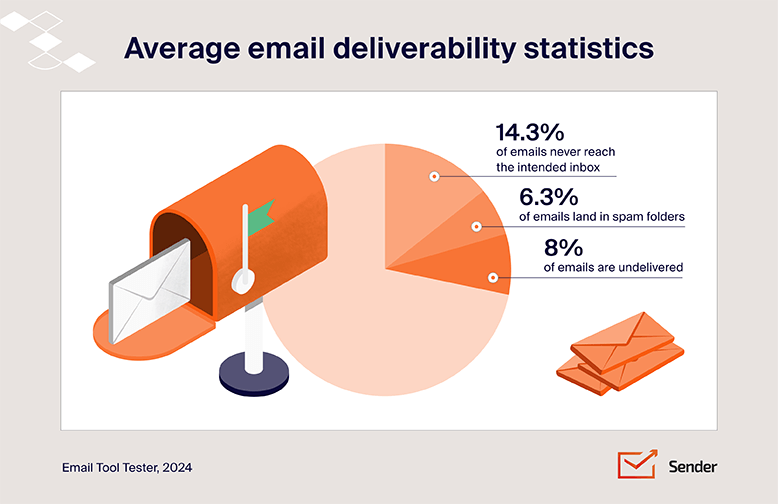
Mobile Device Email Marketing Statistics
People open their emails on mobile more than on desktops. Here are some interesting mobile email marketing statistics:
- 75% of Gmail users use their mobile device to access their accounts.*
- One out of every 3 clicks in an email is registered on a mobile device.*
- 60% of people check their emails first thing in the morning on their smartphones.*
- iPhone email app accounted for 29% of email opens. Gmail was ranked second with a 28% open share.*
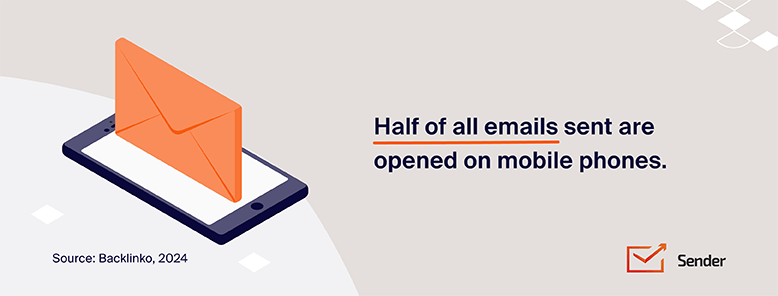
Email Unsubscribe Rates
Email unsubscribers show that your content is not really valuable to your audience. Data from multiple sources have suggested average unsubscribe rates:
- The average unsubscribe rates vary between 0.07% and 0.2%;
- The unsubscribe rates have fallen down to 0.03% in the past year;
- Spam complaint rate has more than doubled to 0.07% during the same time, meaning more people are complaining rather than just unsubscribing.
Global Email Usage Data
If you want to know how many people use email worldwide, we’ve got some latest data. Here are the current global email user statistics:
- Number of email users is set to cross 4.6 billion, a 3% increase from 2024;
- People using emails are forecasted to grow by 8.2% in the next 3 years and hit 4.84 billion by 2027;
- Personal users have multiple email accounts, with an average user having 1.86 accounts in 2022;
- Apple Mail is the most popular email client worldwide with 58% market share, followed by Gmail (29%).
If you love numbers as much as we do, check out these fire articles:
- Email Marketing KPIs: Metrics for Email Analytics
- Email Analytics: How to Improve Your Email Open Rate
- 18 Lead Nurturing Statistics to Lift Your Sales in 2024
*Sources:
- https://www.barilliance.com/email-marketing-statistics/
- https://emarsys.com/press-release/emarsys-survey-finds-smbs-quickly-adapting-omnichannel-paradigm-compete/
- https://www.emailtooltester.com/en/blog/email-marketing-statistics/
- https://www.emailtooltester.com/en/blog/email-deliverability-statistics/
- https://www.emailtooltester.com/en/blog/spam-statistics/
- https://www.emailtooltester.com/en/blog/ecommerce-email-marketing-statistics/
- https://knowledgebase.constantcontact.com/email-digital-marketing/articles/KnowledgeBase/5409-average-industry-rates?lang=en_US
- https://www.litmus.com/wp-content/uploads/pdf/The-2023-State-of-Email-Workflows-Report.pdf
- https://www.litmus.com/wp-content/uploads/pdf/The-2023-State-of-Email-Report.pdf
- https://contentmarketinginstitute.com/wp-content/uploads/2021/10/B2B_2022_Research.pdf
- https://emt.gartnerweb.com/ngw/globalassets/en/marketing/documents/digital_iq_email_marketing_benchmarks_2022.pdf
- https://www.mckinsey.com/capabilities/growth-marketing-and-sales/our-insights/why-marketers-should-keep-sending-you-emails
- https://abmatic.ai/blog/power-of-personalization-in-email-marketing
- https://www.constantcontact.com/blog/email-marketing-research-and-statistics/
- https://www.getresponse.com/resources/reports/email-marketing-benchmarks
- https://www.statista.com/statistics/812060/email-marketing-revenue-worldwide/
- https://www.hubspot.com/state-of-marketing
- https://www.brafton.com/blog/email-marketing/the-history-of-email-marketing/
- https://sopro.io/resources/whitepapers/the-state-of-prospecting-23/
- https://contentmarketinginstitute.com/articles/b2b-power-content-marketing-research/
- https://blog.hubspot.com/marketing/hubspot-blog-marketing-industry-trends-report
- https://www.gartner.com/en/marketing/research/digital-iq-email-marketing-benchmarks
- https://truelist.co/blog/mobile-email-statistics/
- https://www.pathwire.com/research/accessibility-email-inbox/
- https://backlinko.com/email-marketing-stats
- https://www.litmus.com/email-client-market-share/
- https://www.litmus.com/blog/infographic-the-roi-of-email-marketing/
- https://www.salecycle.com/blog/featured-en-us/18-essential-email-marketing-statistics/
- https://www.emarketer.com/insights/email-marketing-personalization-trends/
- https://www.notifyvisitors.com/blog/segmentation-statistics/
- https://www.sequeldm.com/directmailreport/
- https://www.klaviyo.com/marketing-resources/email-benchmarks-by-industry
- https://www.campaignmonitor.com/resources/guides/email-marketing-new-rules/
- https://www.getresponse.com/resources/reports/email-marketing-benchmarks
- https://www.drip.com/blog/email-marketing-statistics
- https://snov.io/blog/email-frequency-best-practices/
- https://www.radicati.com/wp/wp-content/uploads/2023/04/Email-Statistics-Report-2023-2027-Executive-Summary.pdf
- https://www.validity.com/wp-content/uploads/2024/02/The-State-of-Email-in-2024-Keeping-Ahead-of-the-Curve.pdf
- https://debounce.io/email-spam-statistics/



